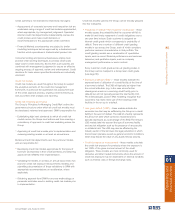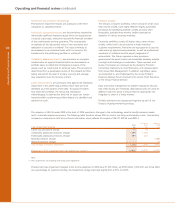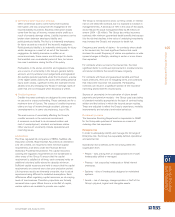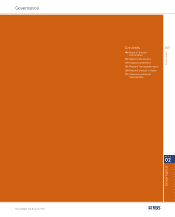RBS 2005 Annual Report Download - page 99
Download and view the complete annual report
Please find page 99 of the 2005 RBS annual report below. You can navigate through the pages in the report by either clicking on the pages listed below, or by using the keyword search tool below to find specific information within the annual report.
section
01
Operating and
financial review
97
Operating and financial review
Annual Report and Accounts 2005
Short term wholesale deposits are taken from a wide range of
counterparties, with the largest single depositor continuing to
represent less than 1% of the Group’s total funding. The level
of funding from short term unsecured debt issuance and bank
deposits, excluding repos and short positions, has increased
by £20,020 million (18%) to represent 20% of total funding
excluding other liabilities at 31 December 2005, reflecting the
higher rate of growth in customer loans and advances (see
‘net customer activity’ below).
Short positions and repos with corporate, institutional
customers and banks are undertaken primarily by RBS
Greenwich Capital in the US and by Financial Markets. Repo
and short positions increased by £19,687 million (17%) to
represent 21% of total funding excluding other liabilities at 31
December 2005.
The Group remains well placed to access various wholesale
funding sources from a wide range of counterparties and
markets. The changing mix evident between customer repo,
deposits by banks, debt securities in issue, and shorts
primarily reflects comparative pricing, maturity considerations
and investor/counterparty demand rather than a material
perceived trend.
2005 2004
Net customer activity £m £m
Loans and advances to customers (gross, excluding reverse repos) 372,223 299,235
Customer accounts (excluding repos) 294,113 241,181
Customer lending less customer accounts 78,110 58,054
Loans and advances to customers as a % of customer accounts (excluding repos) 126.6% 124.1%
In prevailing economic conditions and with interest rates at
relatively low historical levels in the UK, US and Europe, it is
anticipated that the growth in demand for further borrowing by
customers is likely, in the medium term, to continue to exceed
that for customer deposits received, thus increasing net
customer lending further and increasing gradually over time
the Group’s dependence on the wholesale market for funding.
The Group evaluates on a regular basis a range of balance
sheet management and term funding strategies to address the
consequent potential impact on its structural liquidity risk
position and maintain that within its normal policy parameters.
Management of term structure
The degree of maturity mismatch within the overall long-term
structure of the Group’s assets and liabilities is also managed
within internal policy limits, to ensure that term asset
commitments may be funded on an economic basis over their
life. In managing its overall term structure, the Group analyses
and takes into account the effect of retail and corporate
customer behaviour on actual asset and liability maturities
where they differ materially from the underlying contractual
maturities.
Stress testing
The maintenance of high quality credit ratings is recognised as
an important component in the management of the Group’s
liquidity risk. Credit ratings affect the Group’s ability to raise,
and the cost of raising, funds from the wholesale market and
the need to provide collateral in respect of, for example,
changes in the mark-to-market value of derivative transactions.
Given its strong credit ratings, the impact of a single notch
downgrade would, if it occurred, be expected to have a
relatively small impact on the Group’s economic access to
liquidity. More severe downgrades would have a progressively
greater impact but have an increasingly lower probability of
occurrence.
As part of its stress testing of its access to sufficient liquidity,
the Group regularly evaluates the potential impact of a range
of levels of downgrade in its credit ratings and carries out
stress tests of other relevant scenarios and sensitivity analyses.
Contingency funding plans are maintained to anticipate and
respond to any approaching or actual material deterioration in
market conditions or in the Group’s credit ratings, and the
Group remains confident of its ability to manage its liquidity
requirements effectively in all such circumstances.
Daily risk management
The primary focus of the Group’s day to day risk management
activity is to ensure access to sufficient liquidity to meet its
cashflow obligations within key time horizons out to one month
ahead. The short-term maturity structure of the Group’s
liabilities and assets is managed on a daily basis to ensure that
all material cashflow obligations, and potential cashflows
arising from undrawn commitments and other contingent
obligations, can be met as they arise from day to day, either
from cash inflows, from maturing assets, new borrowing or the
sale or repurchase of various debt securities held (after
allowing for appropriate haircuts).
Net customer activity
Net customer lending, excluding repos, rose by £20,056 million as the growth in loans and advances to customers continued to
exceed the growth in customer accounts, thus increasing the degree of reliance on wholesale market funding to support loan growth.
























